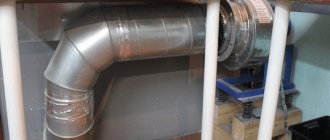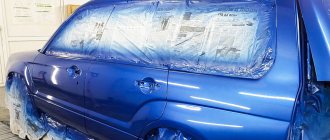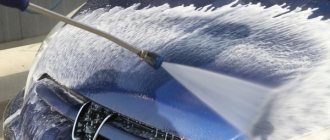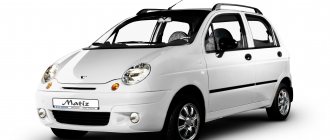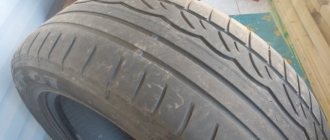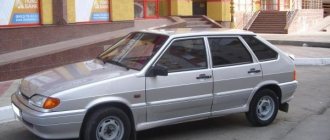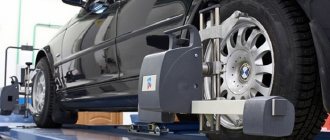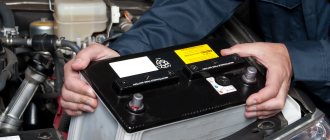Packaging and equipment
This coloring agent is supplied for sale in packaging containing:
- four bottles (each 750 ml) with the main substance;
- hardener (1 l);
- anti-gravel gun designed to work with raptor;
- instructions with detailed recommendations for use;
- quality passport.
Sets may be black or off-white in color. Moreover, the latter can be transformed into any desired shade without much difficulty. To paint in different colors, 10% of the coloring pigment is added to the base.
see also
Comments 50
I'm interested in your opinion. HOW DO YOU LOOK AT THE CRUISER BEING PAINTED WITH RAPTOR IN 2 COLORS TOP BLACK THEN A DIVIDING LINE OR A PATTERN AND ANOTHER COLOR?
There are also structural rollers)) you can apply the design with a roller! They are rubber with embossed designs or patterns, you can embellish a simple raptor with a pattern))!
...I recently painted small things with hammer-effect enamel (not Raptor, of course, but the texture is similar), so here is the factory recommendation - DO NOT dilute the paint and apply it with a velor roller (I applied it with a foam roller).
Safety precautions during operation
In order not to harm your health, you need to know the dangers of working with dyes. So, you need to consider the following points:
- The mixture ignites;
- With prolonged inhalation and contact of the product with mucous membranes, irritation occurs;
- If the product gets on the skin, it will cause dryness and burning;
- If you breathe the product for a long time, you will feel dizzy.
To protect your health you need:
- Take care of good ventilation if work is carried out indoors. Of course, it is better if a built-in ventilation system is installed, but you can simply open the doors. Wear a respirator and safety glasses;
- Keep paint and painted items away from flammable objects;
- Tools used during work and in contact with the Raptor are placed in a container with water so that they do not freeze, and they can be used again if necessary;
- In order not to stain clothes, wear special protective products;
To avoid getting your clothes dirty, wear special protective clothing.
Raptor paint is an ideal anti-corrosion and anti-gravel paint, the color is perfectly protected from fading in the sun, and will delight the owner with an aesthetically pleasing appearance for a long time. Painting with Raptor yourself is also possible, it saves money, but you need to take care of your own safety, take into account compliance with all work rules in order to properly cover the car and get the desired result.
What will happen as a result
The paint and varnish market is rich in a variety of products that provide all types of exterior coatings for vehicles. They block the interaction of metal elements with negative factors, which include the following phenomena:
- moisture;
- ultraviolet;
- minor mechanical impacts;
- thermal fluctuations, etc.
By applying the Raptor coating with your own hands, the car owner forms a strong polyurethane layer on the outside, which takes care of preventing body defects for a long period. This paint is resistant to contamination, prolonged exposure to the sun, and even exposure to chemicals, which are used in large quantities by utility workers.
As a result of processing, the surface becomes matte and slightly rough, like an orange peel. There is no gloss, which does not prevent the appearance from being aesthetic and original. After the work is completed, the machines are not polished, since this process will only damage the protection.
Application methods
In fact, painting a car with Raptor is not much different from using traditional paints and varnishes. However, the newfangled material is less “capricious” than conventional car paints. You can even apply it outdoors, but it is advisable to avoid this approach so as not to get negative effects from dust, moisture, wind or other external factors.
We recommend following a specific application order:
Before you start processing, you should get rid of removable elements on the body, including mirrors, wheels, bumpers, etc. If there are problem areas with rust, mold or other types of external damage, you will have to clean these areas from damage
You also need to level, putty and straighten any possible dents or depressions. We get rid of the glossy layer using special abrasive discs, which will help the new anti-gravel coating to better adhere to the outside. It is important to pre-etch with the proprietary special primer ACID#8 U-POL. If there are plastic elements, then adhesive primers are used. The layers are applied evenly with pauses for drying.
It is necessary to refrain from extreme conquest of difficult trails for some time (about three weeks) after treatment. This will make it possible to fully form a high-quality coating.
The result will be a shagreen layer. The degree of its relief can be adjusted using a spray gun during processing. At higher pressure the format will be smoother.
Preparatory work before painting
Painting a car with Raptor creates the most durable and high-quality polyurethane coating. Paint is used to form a protective layer on body parts and wheels. The material protects the body from ultraviolet radiation, water and mechanical damage, i.e. the product eliminates the car’s vulnerabilities.
The manufacturer initially developed the substance for coloring wooden and cement products to protect against water. Now the purpose of Raptor is reduced to treating car bodies; it is important to coat SUVs and cars that are used in difficult conditions with the composition.
Do-it-yourself Raptor painting does not create a visible change in the body, but it becomes much stronger and prevents damage. Other positive properties include:
- tolerates sunlight well;
- resistant to many chemicals;
- can be cleaned from dust and dirt;
- creates reliable protection against rust.
Raptor coating does not have to be carried out in a specially prepared room
You can cover the body with Raptor yourself, but you need some basic knowledge about this procedure. Before starting work, you need to prepare the machine. If the body is completely to be painted, then it is necessary to dismantle the removable equipment (external lighting fixtures, bumper, mirrors). In case of partial coverage, the work area should be prepared.
Places of mechanical damage, paint peeling, and corrosion must be cleaned. Cover areas of pure metal with a primer mixture. Degrease the remaining cleaned areas. If there are depressions on the body, straightening and puttying operations will be required. After all these manipulations, you will need P80 sandpaper to remove the glossy layer to a matte surface. To cover parts that cannot be processed, you will need
The Raptor coating has good properties. When working, it is not afraid of wind and exposure to the sun. Painting operations should be carried out in a covered box, hangar or garage.
Painting a car with raptor is not a complicated process and can be done by a car enthusiast, but it requires careful preliminary preparation. If painting will be done over the entire body of the car, then initially you need to remove all the attached parts from the body: bumpers, headlights, corners, mirrors, and so on.
Then traces of rust and peeling paint are removed from the body. It is recommended to prime areas of the body with exposed metal with ACID #8 primer. If necessary, the body is straightened and puttied in places of dents. The surface should be degreased with anti-silicone cleaner S2001.
At the next stage of preparing the body for painting, P80 sandpaper is used to remove the gloss. The surface to be painted with raptor should be matte. All parts of the car that remain on the body and will not be painted should be covered with protective material, using masking tape as fastening.
The instructions for using Raptor say that it has excellent adhesion to painted surfaces, so the painting procedure can be carried out even outdoors, without fear of the sun, wind and dust. However, it is better to carry out painting in a garage in the absence of dust, on a clean and grease-free body.
The cost of "pleasure"
How much does Raptor paint cost? The average cost of a standard set of four cylinders with paint and hardener is about 6 thousand rubles. A set with a pistol will cost an average of 7.7 thousand rubles. The total price of Raptor coverage including the pistol will cost 13.7 thousand rubles.
Raptor painting price. To paint a car with Raptor you will need at least 3 sets, and this “pleasure” will cost 18 – 24 thousand rubles. subject to self-staining. If you decide to paint the car in a workshop, then the price of painting the car with Raptor will be higher by the amount of the cost of the master’s work (about 10 - 20 thousand rudders). Painting a Raptor with your own hands is carried out in several stages, let's look at it in detail.
Painting technology
As already mentioned, the paint application procedure is simple and you don’t have to put in much effort. But, nevertheless, painting is carried out according to a certain algorithm, so as not to spoil the surface of the body and not harm your own health.
Surface preparation
Initially, you should prepare the car body for painting, especially if the substance will be applied to its entire surface. At the first stage, we free the body from all the parts located on it: headlights, sidelights, bumpers, mirrors, etc. After this, carefully inspect the surface. In places where there are defects, we sand to remove rust or peeling paint. If there are dents, they should be straightened. Open areas must be degreased and primed.
After we have treated the problem areas, we begin to remove the gloss from the entire body using R-80 sandpaper. At the final stage of preparing the car for painting, we protect all non-removable elements with film, paper and masking tape.
Preparation of materials and tools
After the car is ready for painting, we prepare materials and tools for the procedure. Rags, paint brushes and rollers should be at hand. It is better to do the main work using a special spray gun. Of course, you can use a roller, but it should be noted that the quality of the surface will be slightly different from what you get after spraying.
To ensure a high-quality surface, it is important to purchase the required amount of paint. To do this, certain calculations are carried out, since the consumption of the substance depends on the condition of the surface and the number of layers applied
If you find it difficult to make the calculation yourself, it is better to contact specialists with this question.
As for preparing Raptor paint for painting, following the instructions, it must be mixed with a hardener in a ratio of 3:1. Moreover, on the container itself where the material is located, there is a special line at the level of which the hardener should be poured.
After this, the jar is tightly closed and shaken thoroughly for several minutes. There are hardeners with different drying intervals. Thanks to this, you can regulate the drying time of the painted surface.
Coating
After the mixture is ready for use, put a gun on the jar. The sprayer itself is connected to the compressor via a special hose. This is how painting is done.
There are some tips for applying paint:
- It is better to start painting from the roof of the body.
- Movements should not be sudden; it is necessary to ensure that the layer is applied evenly.
- The distance from the surface to the sprayer should be 40-50 cm.
- The time to dry the first layer is about an hour, provided that the air temperature is 20°C.
After the second layer of the substance is applied, it will take about a week for the paint to dry completely. But this does not mean that the car cannot be used. You can use it within 12 hours after completion of the work, but make sure that no load is placed on the surface.
How to paint a car with raptor?
Preparatory stage
Preparation for painting is one of the most important processes, since the final result largely depends on the quality of its implementation. First of all, it is necessary to dismantle the bumper, headlights, mirrors, handles, windshield wipers and other attachments. Everything that cannot be painted, but cannot be removed, is very carefully covered with a protective material (film or paper) and masking tape, otherwise it will be almost impossible to wash off any accidental paint.
The algorithm for further actions is as follows:
- Using a sander, paint and varnish coating and traces of rust are removed from the surface of the body;
- the resulting dust and dirt are blown out with a compressor;
- cleaned areas are degreased with white spirit or anti-silicone;
- areas with dents, chips or scratches are straightened with a special putty;
- after the surface has dried, it is necessary to blow it again;
- The areas to be painted are treated with a primer for metal surfaces.
Raptor staining
According to the manufacturer's recommendations, raptor coating does not have to be carried out in a specially prepared room - it can be done outside without worrying about weather conditions. However, as practice shows, when applying the composition to car bodies, it is better to avoid contact with dust and small particles of dirt.
How to paint a raptor body? The process consists of the following steps:
- The coloring composition is mixed with the hardener in a ratio of 3:1 (mixing is done in a can of paint). It is important to remember that the resulting mixture is suitable for use for three hours.
- Screw the gun with the hose onto the can.
- Painting begins with the roof of the car. Using smooth, even movements, holding the gun at a distance of 50 cm from the area to be painted, apply the first layer.
- At a temperature within +20°C, the coating will dry in 30-60 minutes, after which you can begin applying the second layer.
- Since this substance has a very pungent and unpleasant odor, and is also toxic, the car should dry in a well-ventilated area. Complete polymerization of the material occurs on 21 days. However, careful use of the vehicle is allowed 7-10 days after painting.
Are there any negative aspects to using such a solution?
In all types of work there are positive and negative aspects, the only question is their quantity.
View gallery
Possible disadvantages include the following:
- contraindications to the use of varnish substances over the protective layer, so the coating will be permanently matte;
- the external appearance of the treated body will resemble the surface of an orange peel; some car enthusiasts may not like this;
- Deviation from the recommended technology will lead to the appearance of defects;
- long process of complete drying (polymerization).
For the final result, these shortcomings are not significant. Now you know what this car coating is.
Raptor paint for car body protection
When operating a vehicle off-road, there is a high probability of mechanical damage to its body. The appearance of a defect on the body, even a small one from a rebound stone, will lead to the formation of corrosion over time. To prevent such a problem from arising, modern SUVs have plastic linings to protect the body in particularly hazardous areas. But it will not be possible to completely cover the car body with plastic, and Raptor paint can be used to protect the metal elements.
Differences between Titan and Raptor
Titanium paint is considered more durable and hard after drying. This is due to the presence of 70% polymers in the composition, while in Raptor there are only 30%. Other paint differences are:
- The base of “Titan” is white, so it can be tinted in any shade. Different brands of colors are suitable for this paint. For Raptor, only pigments recommended by the manufacturer are used.
- The Titan has a higher dry residue and its consumption is lower than that of the Raptor.
- “Titanium” should be applied with a gravel gun. The Raptor coating is best done using a special branded gun, which is able to regulate the size of the shagreen pimples.
- According to user reviews, Titan better withstands negative and even extreme temperatures, since it was developed specifically for harsh regions.
- Raptor paint has been on the market for 5 years longer than Titan. Therefore, some craftsmen are accustomed to “Raptor” and have more confidence in paintwork materials. The first versions of the paint were somewhat worse, but then the composition was improved and became ideal for metal and plastic.
In general, the difference between these two paints is not critical, because both paints are widely used in car repair shops and have no obvious advantage over each other
It is only important to prepare the base correctly, observe the number of layers and drying time, and then any material will serve for a long time and will reliably protect the car from damage
What is Raptor paint for a car?
Raptor is a special product designed to protect the body of cars that often travel off-road. The paint composition has increased strength characteristics, due to which, after applying it to the car body, the impact resistance of the body increases.
Please note: In addition to protection from mechanical damage, Raptor also protects the car body from other negative factors, such as direct sunlight, exposure to moisture and chemicals.
Raptor paint is based on a urethane composition. It is worth understanding that Raptor is precisely paint, which, when applied to the car body, acquires the appropriate tone. Therefore, Raptor can be used by drivers to not only protect the body from future damage, but also to paint over existing defects.
The Raptor paint composition can be applied both to already painted surfaces and to fresh primer, for example, if work was carried out to restore the car body. The surface painted with Raptor is not as shiny as after applying regular car paint, which is why it is more often used specifically for SUVs. The structure of the applied Raptor layer is slightly rough with clearly defined grains.
Please note: If you need to protect the body of a city car from external negative factors, you can use Gravitex.
Raptor can be used for application both on the entire surface of the body and on its individual parts. You can paint with Raptor using regular brushes and rollers, or using a spray gun.
Advantages and disadvantages
When applied to a car body, a polyurethane coating forms a protective film, which has a number of advantages over conventional car paint, namely:
- high strength of the material;
- resistance to friction;
- resistance to most chemical elements;
- easy to clean;
- does not fade in the sun;
- reliable surface protection against corrosion.
For all its positive aspects, the Raptor is not without its shortcomings. The following can be distinguished from them:
- the coating cannot be varnished, so it will always be matte;
- the surface has the appearance of pebbled leather, which does not always look aesthetically pleasing;
- If the painting technology is not followed, chips may occur.
How to protect thresholds from rust?
External processing.
As was written in the introduction, external processing is not as important as internal treatment, but nevertheless, it is the external part of the threshold that determines the appearance of the car. And in order to improve it, many motorists install plastic body kits. The appearance is supposedly better and the chips are not visible. Colleagues are a huge mistake. A non-standard body kit harms the threshold more than the lack of paint!
See what happens under the plastic door sills:
The fact is that dust inevitably accumulates under the linings; naturally, in our climate, the dust collects water and does not dry out most of the time, and with every change in temperature or driving over uneven surfaces, the dust collected under the lining strips off the paint! The result is that the threshold rots not only from the inside, but also from the outside.
We agreed - we will remove the non-standard sill trims...
The thresholds themselves, over time, lose their paint due to the abrasive effect of road dirt. We already have a separate article on our website about how to paint thresholds; we won’t repeat it.
To reduce the abrasive effect of road dirt, be sure to install mud flaps on the front wheels. With mudguards, the paint on the thresholds and arches will last several years longer, and most importantly, the amount of water getting inside the threshold will be reduced.
The author of the article had a case - a Volga 3102, which had been used all its life in Volgograd, but had lived for one winter in St. Petersburg, and by coincidence, the Volga was without one front mudguard, came to overcook the threshold, so - the threshold and the box on the side without the mudguard were ROTTEN, while while the threshold on the other side did not even require overcooking of the lining, although it had damage from impact and chipped paint.
We agreed - we will definitely install mudguards on the front wheels.
To summarize, on the outside:
- removing non-standard linings
- Be sure to restore the factory paintwork
- Be sure to install mudguards
Internal processing.
The network is full of recommendations on materials for treating hidden cavities, from pushsal, mining and Movil to modern corrosion inhibitors, we will also give our recommendations, but before treating the threshold, it must be washed! This is done very simply - the plugs are removed from both sides and the threshold is washed with plenty of water. Here's a video using an example of a 124 Mercedes:
But we shook out so much sand when we were digesting the thresholds on the Mazda 3 2007:
We agreed - before treating anything hidden from the cavity for rust, be sure to wash the threshold and dry it for several days.
Mining is the cheapest option.
The tradition of pouring waste into the thresholds dates back to the times of the USSR, and indeed, 2-3 liters of waste into the threshold at each oil change extends its life by 5-10 years!
They write online that you can’t pour mining, it will accelerate corrosion, etc. - nonsense! Working out helps, the author of the article was a 1993 Volga. which had factory thresholds in 2022 because it was spilled with drainage at every oil change. Think about it - the most rotting Volga (31029) had its original thresholds 25 years after production, only thanks to development!
Extraction perfectly impregnates rust and blocks the access of air to the metal, respectively, the rate of decay slows down significantly.
The myth that working out accelerates corrosion, and if you pour oil into the sills, then only fresh oil, was started by marketers (you have to sell anti-corrosion compounds)…
The development is not without its drawbacks:
- It is harmful to health because... It is unknown what it is made of, and what additives were used in it, and what it washed out of the engine!
- The waste sometimes has a rather foul odor, which takes a long time to dissipate.
- Cavities need to be drained at least once a season.
For those interested, crude oil is an excellent substitute for waste, is much less harmful to health, and is much less easily washed off with water, but it is quite difficult to get.
Movil and pushsalo are a cheap option.
Both were developed a long time ago. Pussalo has been used for more than 200 years to preserve guns and shells, and Movil (Moscow - Vilnius) was developed as an anti-corrosion agent in the early 70s.
Both are petroleum derivatives: pushsalo - thickened petroleum oil, Movil - a mixture of lithol, motor oil, drying oil, kerosene and corrosion inhibitors. Both anticorrosives have the same principle of action - to limit the access of oxygen to the treated surface.
If Movil is relatively liquid, and like a waste product, it wets the rust (albeit worse). That gun lard, at normal temperatures, can be cut with a knife and it is only applied hot, which is not always possible in anti-corrosion treatment, so using it to protect thresholds is nonsense, but covering the bottom for preservation, on top of mastic, for a long period of parking is quite option.
Movil is an expensive alternative to mining. Because it smells just as bad and has just as bad an effect on the health of those who smell it.
Movil also needs to be updated periodically because Over time it dries out and cracks.
Modern anti-corrosion agents...
Naturally, over time, manufacturers have improved anti-corrosion agents, and in addition to the “collective farm methods” given above, there are quite modern compositions:
Most of them are analogues of Movil, but differ in drying speed and corrosion inhibitors. The most important advantage is that they can be applied less frequently, and they are more expensive to purchase, but they also require updating less often. Agree - most people drive a car for 2-3 years and it is much more profitable to carry out anti-corrosion treatment once with high-quality materials than to update the Movil every year for money.
We agreed - the protection of hidden cavities consists of 2 stages:
- Washing the threshold from dirt from the inside
- Treatment with anti-corrosion compound.
That's all for me today. If you still have questions about how to protect car sills from corrosion, or if you want to tell us about your experience of using anti-corrosion compounds, write comments.
Good afternoon, dear readers and guests of the blog. Today in this article we will talk about treating car thresholds with your own hands to protect against rust. All car enthusiasts have encountered the problem of rusty thresholds. It is relevant for any car operating on the roads of the country.
Anti-corrosion treatment of car thresholds can solve the problem of rust. If you let the corrosion process take its course, then in a few years you will have to completely change the thresholds of the car. It is easier to prevent rust than to subsequently deal with its destructive effects.
At the end of the article you will find an interesting and fascinating video. Shows the destructive effect of rust on a car.
How to apply correctly
You can paint your car yourself, for example, in a garage. You need to work with the Raptor composition wearing a respirator and with the doors open. You can entrust the painting of your car to a specialist. In this case, painting will cost more.
Required materials and tools
To perform staining you need the following tools and materials:
- primer (adhesion promoter) for plastic;
- two-component primer (acid, etching) for metal;
- putty;
- paint and hardener;
- pigment;
- spray gun;
- tassels;
- degreasing solvents;
- tools for polishing and abrasive processing (sandpaper P80-P280);
- rags, sponges.
Preparing for coloring
Before painting, the surface must be prepared, that is, cleaned of dirt and primed. After preparing the car, the composition is prepared. A hardener is added to the paint in a ratio of 3 to 1, that is, 250 ml of hardener is taken per 0.75 liters of paint.
If necessary, pigment is added to the Raptor composition (5-10 percent of the total volume). To obtain a more liquid solution, add a solvent (15-20 percent of the total volume). Shake the mixture in the jar for 2-3 minutes.
Surface preparation consists of the following steps:
- remove dirt, dust, grease;
- clean rust spots;
- remove elements that cannot be painted (bumper, headlight covers, mirrors);
- remove cracked layers of varnish and paint;
- smooth out unevenness using putty;
- places of deformation are subjected to straightening;
- go over the entire surface with sandpaper (for better adhesion of the Raptor compound);
- treat the surface with a solvent, then with a primer;
- wait several hours until completely dry;
- cover areas not to be painted with tape and cover with film;
- put on a respirator and paint.
Painting technology
The car is painted as follows:
- prepare the composition (paint, hardener and, if necessary, pigment and solvent);
- shake the mixture thoroughly;
- remove the lid, attach a paint sprayer to the jar with the finished composition;
- regulate pressure (jet size);
- the finished mixture is used for 60 minutes;
- painting is carried out with a spray gun, roller or brush;
- if a sprayer is used, it is recommended to spray paint from a distance of 40-50 cm;
- they paint the interior parts of the body for testing to look at the texture (how the Raptor lays down);
- paint the entire surface in one layer and wait 60 minutes for the paint to dry;
- paint over all places, leaving no voids;
- after the first layer has dried, paint the surface one more time;
- the optimal number of layers is 2 (two).
How long does it take to dry?
After applying the first layer to the surface, wait 60 minutes for it to dry. Then the car is painted a second time. Application of 2 layers is done by spraying over the first. During drying, you need to ensure that water, dust and no objects are placed on the surface for 60 minutes. The disappearance of stickiness to the touch occurs in 1 hour at a temperature of 20 degrees Celsius.
It is not recommended to drive the car until the paint has dried. In the first 72 hours after painting, you need to ensure that the coating does not come into contact with water. Complete drying of the painted surface occurs within 5-7 days. Polymerization lasts 21 days. For the first month after painting, the car should be protected from moisture and dirt.
How to correctly calculate car paint consumption
The consumption of Raptor depends on the area of the surface to be painted. Before buying paint you need to make a calculation
It is important to know the length, width and height of the body. Calculate the surface area of each side
To do this, the length is multiplied by the width (S=A*B). The areas to be painted on each side of the car are summed up.
As a rule, 8 liters or 2 Raptor sets are enough for a Niva car. The longer and higher the car, the higher the consumption. For a Toyota car you need to buy 3 packages or 12 liters of paint. The same amount of Raptor products is needed for most cars. The maximum amount of paint is 16 liters or 4 packs.
DIY raptor painting
p, blockquote 7,0,0,0,0 –>
- After stirring, the bottle is screwed to the gun, which, in turn, must be connected to a compressor. You need to adjust the pressure to 2.5–5 atm, depending on the desired texture. Lower pressure will produce a coarser texture, and higher pressure will produce a finer texture.
- The distance and speed of the gun will also affect the texture.
- Adding thinner (up to 10%) will give a smoother finish. For this, it is better to use a special thinner, but a universal acrylic thinner will also work. It is not recommended to use solvents as they will weaken the properties of the coating.
- Experiment with pressure settings and do a test spray on cardboard to find a texture you like.
- Recommended distance is 40–45 cm (up to 150 cm). A closer distance will produce a larger texture.
- You can read about how to make passes with a gun when spraying and about the basic principles of painting in the article “Car painting technology.”
- The time required to spray diluted Raptor is 60 minutes.
- If more than 5 hours have passed since applying the layer, then before applying the next layer you need to sand the surface a little.
- U‑pol recommends applying 2–3 coats of Raptor. More than 3 layers are not recommended.
- Subsequent coats can be applied with a 60 minute drying period between coats.
- Between changing bottles, the gun must be washed for trouble-free spraying. Immediately after use, the gun must also be washed. The gun can be washed with either solvent or acetone.
Spraying with an HVLP spray gun
p, blockquote 8,0,0,0,0 –>
- By applying Raptor with a spray gun you can achieve the smoothest surface.
- Dilute Raptor with thinner by 10–20% of the total volume.
- Apply diluted Raptor with a spray gun with a nozzle of 1.6 - 2 mm.
- The gun should spray with a pressure between 2-4 atm.
- Hold the gun at a distance of 30–60 centimeters from the surface.
- Apply Raptor using long strokes to achieve desired texture.
- Each layer must dry for 1 hour before applying the next layer.
Raptor can be painted with most modern paints. To do this, you need to wait 24 hours after applying it and treat it with Scotch Brite. Next, paint or varnish is applied. This is not a mandatory process, but possible.
p, blockquote 9,0,0,1,0 –>
